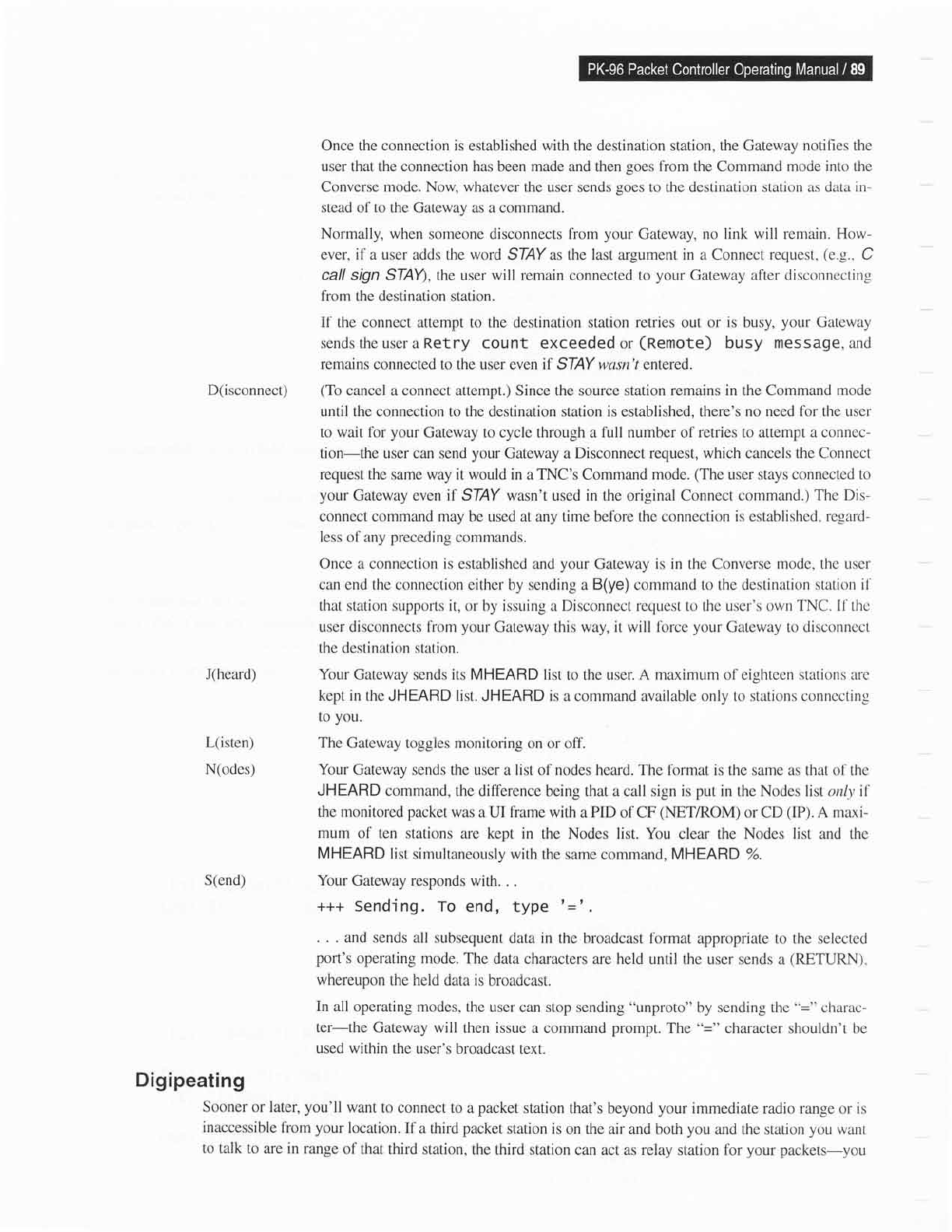Specifications
Table Of Contents

D(isconnect)
J(heard)
L(isten)
N(odes)
Once the connection is
established
with
the destination station,
the
Gateway
notifies the
user that the connection has been made and then
goes
from the Command mode
into
l"he
Converse
mode.
Now,
whatever
the user sends
goes
to the destination station as dater
in-
stead of to the Gateway as a command.
Normally, when
someone disconnects liom
your
Gateway, no
link will remain. How-
ever,
if
a user adds the
word
STAY as the last argument in a Connect
request,
(e.g..
C
call sign STAY, the user will remain connected
to
your
Gateway
after disconnecting
from
the
destination
station.
If
the connect attempt to the destination station retries out or
is
busy,
your
Gateway
sends
the
user
a
Retry
count exceeded or
(Remote)
busy message, and
remains connected
to the user even if STAY wasn't entered.
(To
cancel a connect attempt.)
Since
the
source station
remains in the Command mode
until the connection
to the destination station
is
established,
there's no need for the user
to wait for
your
Gateway to cycle through a full number of
retries
to attempt
a connec-
tion-the user can
send
your
Gateway a
Disconnect request, which cancels the Connect
request
the same way it would in
a
TNC's Command mode.
(The
user stays connected
to
your
Gateway even if
STAY
wasn't
used
in
the original
Connect command.)
The Dis-
connect command may be used at
any
time befbre the connection is established,
regard-
less of any
preceding
commands.
Once a connection is
established and
your
Gateway is in the Converse
mode, the user
can
end
the connection
either by sending a
B(ye)
command to the destination
station if
that station
supports
it,
or by issuing a Disconnect request to the user's own
TNC. Il'thc
user
disconnects fiom
your
Gateway this way, it will fbrce
your
Gateway to disconnect
the
destination station.
Your Gateway
sends
its
MHEARD list to the user. A maximum of eighteen stations arc
kept
in the JHEARD list.
JHEARD
is
a command available only to stations
connccting
to
you.
The Gateway
toggles monitoring
on
or
off.
Your
Gateway sends the
user a list of nodes heard. The format is the same as that of the
JHEARD command,
the difference being that a call sign is
put
in the Nodes list only if
the monitored
packet
was
a UI
frame
with a PID of CF
(NET/ROM)
or CD
(IP).
A maxi-
mum
of
ten stations are kept in
the Nodes list. You clear the Nodes list and the
MHEARD
list simultaneously
with the same command, MHEARD
%.
Your Gateway responds
with. .
.
+++ Sending.
lo
end, type
'='.
.
.
. and sends
all subsequent
data
in
the broadcast format
appropriate to the selected
port's
operating rnode.
The data characters
are held until the user
sends a
(RETURN),
whereupon
the held data is
broadcast.
In
all operating
modes, the
user can stop sending
"unproto"
by
sending
the
"="
charac-
ter-the
Gateway will then issue
a command
prompt.
The
"="
character
shouldn't be
used within
the user's broadcast
text.
Digipeating
S(end)
Sooner or later,
you'll
want
to connect to
a
packet
station
that's beyond
your
immediate radio range
or
is
inaccessible
from your
location. If
a third
packet
station is
on the air and both
you
and the station
you
wanL
to talk
to are in range
of that
third station.
the third station
can act as relay station for
your packets-you










